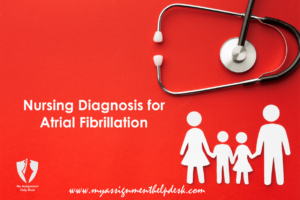Nursing Diagnosis for Stroke
In your nursing career, you will encounter patients suffering from different conditions including stroke. Such patients will require a specialized nursing diagnosis and care. To prepare you to get proper knowledge and skills in attending to stroke patients, your tutors will require you to prepare diagnosis plans for stroke patients.
But what does nursing diagnosis entail? It is the groundwork that you shall carry out as a nurse to establish the patient’s case and then develop a care plan. The nursing diagnosis provides a basis for the choice of intervention measures and monitoring to have an appropriate outcome on the patient. Therefore, a nursing diagnosis for a stroke patient will be specific to such patients and will be different for other patients. This article will guide you on how to write a nursing diagnosis for a stroke patient.
Table of Contents
Who is a stroke patient?
Stroke is any functional abnormality of the brain that is caused by cerebral vessels of the entire cerebrovascular system. This condition is also referred to as infarction or brain attack that affects the cerebrovascular system of the brain. Once the brain is attacked, either because of a haemorrhage in case of an accident, high blood pressure or any other cause, there is an impairment of the cerebral circulation or complete occlusion of the brain vessels.
What are the common Causes of Patients?
The primary causes of stroke include haemorrhage, embolism, and thrombosis. However, thrombosis is the main cause of stroke and commonly affects the carotid arteries leading to thrombotic CVA. Embolic cerebrovascular accident (CVA) occurs when there is a clot that is carried into the cerebral circulation leading to a localized cerebral infarct. Hemorrhagic CVA is caused by other conditions including hypertension, arteriovenous and hypertension.
What are the desired Nursing Diagnosis Outcomes?
Stroke patients may exhibit varying symptoms due to brain damage depending on the immediate cause. However, there are generally accepted nursing diagnosis outcomes for a stroke patients:
- The patient will have an improvement in the level of consciousness and cognition
- The patient will maintain a stable motor and sensory function.
- The patient will maintain stable vital signs and shows no signs of an increase in intracranial pressure (ICP)
- The patient should not show signs of further deterioration in his or her general health.
The outcome may be varied but the intervention of the nurse should help the patient have improved ability and hence better quality of life.
What are the Assessments?
Part of the nursing diagnosis is an assessment of the patient. As such, there should be an assessment of the factors that relate to cerebral perfusion, neurological status, and a review of the vital signs. Assessment does not only form basis for the intervention but also determines whether the patient should be transferred for intense monitoring.
Assessment of Factors Related to Cerebral Perfusion
The nurse should asses the factors that relate to the specific patient that would lead to decreased cerebral perfusion as well as potential increases in ICP. This assessment is intended to determine how the nurse will intervene and follow the patient’s recovery progress. In particular, if there is a decrease in the intracranial adaptive capacity, the patient should be transferred to a more critical area for close monitoring of the ICP and better intervention measures. A vital aspect of this assessment is to determine whether the stroke is evolving or is progressive.
Assessment of the Neurological Status
It is needful for the nurse to make a close assessment and monitor the neurological status of the patient regularly and make a comparison with the expected baseline. This assessment may entail reviewing the level of consciousness (LOC), and the probability of ICP increases. This assessment helps the nurse to understand the location and the level of brain damage. This assessment may also reveal the level of Transient Ischemic Attack (TIA)- a warning for an imminent thrombotic CVA.
Monitoring Blood Pressures
Fluctuations in blood pressure are a key indicator that something could be wrong for a stroke patient. On most occasions, it may indicate that the patient could be suffering from a cerebral injury at the vasomotor brain area. This increase in pressure could be precipitated by hypertension or hypotension. Therefore, the condition must be monitored to ensure that it does not lead to an increase in ICP. Other issues related to blood pressure that should form the basis of nursing diagnosis are possible clot formation or subclavian artery blockage.
Heart Rate and Rhythm
The nurse should also review the heart rate and rhythm to determine if the patient is recording changes in the rates. Two conditions here form the basis for this assessment: bradycardia and Dysrhythmias. Bradycardia may occur due to brain damage, while Dysrhythmias is commonly associated with cardiac diseases, which could precipitate another insult of CVA.
Respiratory Patterns
Respirations also form a vital part of the nursing diagnosis for stroke patients with an interest in the pattern and rhythm. The nurse should carefully monitor the patient to note any irregularities in the respiration patterns, rhythm, and Cheyne –stokes respiration. In the case of anomalies, further assessment should be made to determine if there are cerebral insults at specific locations, which can be determined, or an increase in ICP. Severe irregularities in respiration would require further intervention and possibly the provision of respiratory support.
Evaluation of Pupil changes in vision
The nurse needs to evaluate the pupil and note its size, shape, and reactivity to light. This assessment is commonly done because the pupil reaction to light is regulated by a cranial nerve. Proper pupil reaction to light indicates that the brain stem is still intact. The assessment of pupil size is done to determine if there is an appropriate balance between parasympathetic and sympathetic innervation.
Changes in vision may be characterized by blurred vision or alterations of the visual field. The brain is involved in vision, and visual alterations indicate a need for concern. In particular, the occipital lobe of the brain is involved in visual processing. Therefore, if the patient records a change in vision, it is a safety concern that should influence the intervention measure.
Additional Recommendations
Changes in higher functions such as cognition and speech are a more unambiguous indication of deterioration and an increase in ICP. In particular, seizures could be an indication of increased ICP. Most importantly, in instances where the patient ICP state deteriorates, it requires quick differentiated intervention. Nursing diagnoses for stroke patients should, therefore, be conducted routinely to monitor the progression of the condition and improve intervention measures.




